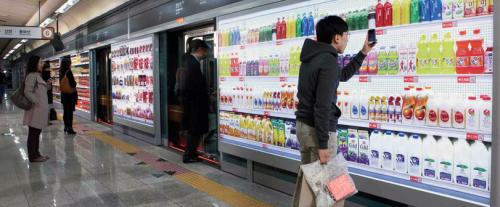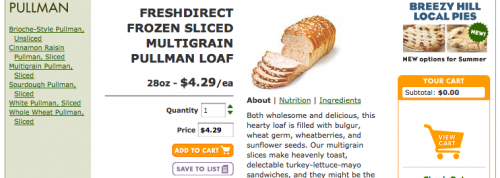Stop-n-Shop
@counternotions tweeted about a neat new advertising campaign designed by ad agency Cheil for Tesco Homeplus, a supermarket in Seoul, South Korea. Cheil created a large wall-length billboard resembling a virtual grocery store inside of a subway station. The ‘store shelves’ display images and prices of a range of common products. Each product has it’s own QR code which can be scanned to add it to an online shopping cart. After the commuting consumer is done shopping, the groceries will then be delivered to their home within the next couple of hours.
The objective of the virtual grocery store is to make productive use of commuters' waiting time by saving shoppers time spent going to the supermarket and, of course, advertising Tesco’s hypermarket which is currently under construction.

Because I have never lived in South Korea, I am not going to speak to how this product would succeed or fail in the context of South Korea. Because I do live in a city with the busiest metro system in the Western Hemisphere and an ever-growing, overworked labor force I am going to discuss this product in the context of my own home metropolis, New York City.
Like a real grocery store the aisles and shelves look bright, glossy, orderly...appealing. Such a cleanly rendered, realistic depiction of store aisles taken out their context and plunged into a space which is both hopeful (the ride home) and dreadful (the often hot, stinky wait) creates a tension which makes it feel almost like an art installation. And yet, in a space where commuters are preconditioned to be inundated with the ever-cycling advertisements of the day, I can't help but wonder if New Yorkers wouldn't just perceive this as an ad and thus be discouraged from actually interacting with it. Unless of course it was a product and an interface that the consumer was already comfortable using, such as Fresh Direct.
Fresh Direct is an online grocery store serving the New York City metrpolitan area. Shoppers order online and then FD delivers them at the customer's desired date and time. Here at Swayspace this is the service that we use to order groceries for lunches in the studio each week. For the first time last week I was in charge of putting in our order. Ordering packaged products like chips and cookies feels normal since these products look and taste the same almost every time I purchase them. Ordering cold cuts, fresh bread and ready-to-eat meals is a different story. A thumbnail image of Fresh Direct’s multigrain pullman loaf doesn’t say much to me when I can’t pick it up to feel it’s weight, density and color. These items arrived like a surprise as though someone else had more control over what arrived in our cardboard boxes than I did. The experience left me a little feeling uneasy. But as with anything, time and repetition would likely breed familiarity and I very well might look forward to tackling my Fresh Direct order while waiting for my ride home.

A few people responded to Tesco’s advertisement by suggesting that we take this model a step further to create whole stores with dynamic aisles of screens. This would allow product placement to be adjusted, sale items highlighted and prices managed from afar while taking up less physical real estate with the lack of aisle space needed for shopping carts and cashiers. Over time and generations could we slowly loose our attachments to the sensory inputs a grocery store: the smell of muffins from the bakery in the morning, the chill in the freezer aisles, the convenient candy bar on your way to checkout. In considering the possibilities of such an interface, the problems of substituting the usual sensory experiences of grocery shopping pose clear hurdles to designers trying to engage their users.
In a city where the urban working dwellers spend long hours in the office and usually can’t wait to get home to their young ones or out to the bar for a cold drink this just might work (that is if you can get used to getting shoved out of the way as you reach to scan the milk). For now, I’ll continue to cherish it when the butcher hands me a slice of turkey to test it’s thickness and when I press my finger into an avocado and know I’ll be able to eat it the next day.